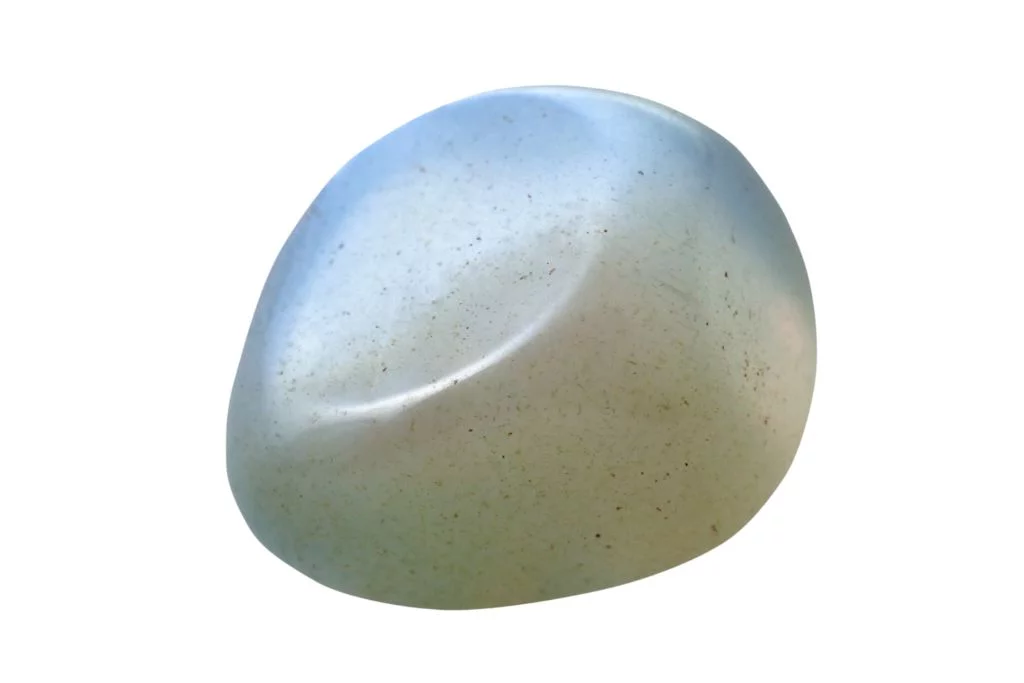Physical Appearance of Adularia
Adularia, also known as moonstone, is a captivating variety of the mineral orthoclase feldspar. This enchanting crystal is renowned for its ethereal appearance and distinctive optical effects. Typically, adularia exhibits a white or colorless base, though it can sometimes appear in pale shades of blue, gray, or peach.
Adularescence – The Moonstone Effect
The most striking feature of adularia is its adularescence, a phenomenon that gives the stone its signature moonlike glow. This optical effect creates a billowy, bluish-white light that appears to float just beneath the surface of the stone. As the crystal is moved, this soft, luminous sheen seems to roll across its face, reminiscent of moonlight gliding over water.
Crystal Structure and Form
Adularia typically forms in prismatic or tabular crystals, often with a pearly luster on its surface. The crystal structure is monoclinic, meaning it has three axes of unequal length. This structure contributes to the stone’s unique light-scattering properties, which are responsible for its captivating visual effects.
Unique Characteristics
One of the most intriguing aspects of adularia is its chatoyancy, or cat’s eye effect. Some specimens exhibit a thin, bright line across the surface that shifts as the stone is rotated. Additionally, high-quality adularia may display asterism, a star-like pattern visible when light is reflected off the crystal’s surface. These optical phenomena, combined with its soft, ethereal glow, make adularia a truly mesmerizing and highly sought-after gemstone in the world of mineralogy and jewelry.
Historical and Cultural Significance of Adularia
Adularia, also known as moonstone, has been revered across cultures for centuries. Ancient Romans believed it was formed from solidified moonlight, while in India, it was considered a sacred stone. The gem has been associated with lunar deities and used in religious ceremonies, particularly in Hindu traditions. Its soft, ethereal glow has inspired countless myths and legends, often linking it to love, fertility, and intuition.
Metaphysical Associations
In metaphysical circles, adularia is highly prized for its alleged spiritual properties. It is believed to enhance intuition, promote emotional balance, and facilitate inner growth. Many practitioners use it for chakra healing, particularly focusing on the crown and third eye chakras. The stone is thought to possess a soothing energy that can alleviate stress, anxiety, and emotional turmoil.
Common Uses and Applications
Adularia finds widespread use in jewelry, often set in silver to enhance its lunar qualities. It is a popular choice for engagement rings, symbolizing love and new beginnings. In crystal healing, it is used in meditation practices, placed on altars, or worn as a talisman. Some people keep adularia under their pillow to promote restful sleep and vivid dreams. Modern wellness enthusiasts incorporate it into crystal grids or use it in conjunction with other stones for various healing purposes.
Benefits and Healing Properties
Proponents of crystal healing attribute numerous benefits to adularia. It is said to enhance feminine energies, support hormonal balance, and aid in fertility issues. The stone is believed to foster creativity, intuition, and psychic abilities. Some claim it can help alleviate skin conditions, digestive issues, and menstrual discomfort. While these benefits are not scientifically proven, many individuals report positive experiences with adularia in their personal spiritual and wellness practices.

